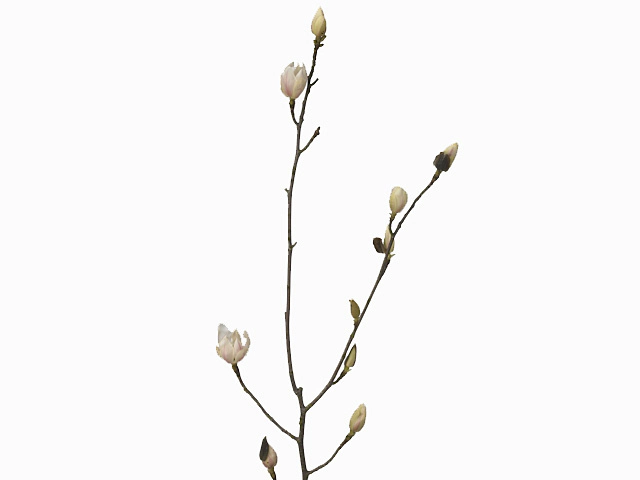Magnolia x soulangeana

| Leaf margin | Entire; Undulate |
| Flower scent | Weak |
| Leaf type | Foliage leaf |
| Winter hardness | Good (USDA-zone 5, 6) |
| Flower color | Light red pink; White |
| Leaf, general shape | Oval / elliptic |
| Flowering month(s) | April; May |
| Leaf duration | Deciduous |
| Flowering period | Spring flowering |
| soil pH requirement | Slightly acidic (pH 4,5 - 6,5); Neutral (pH 6,5 - 7,5) |
| Light conditions | Sunny |
| Leaf division | Simple |
| Plant, growth type | Erect |
| Flower color distribution | Marmorate |
| Toxicity (if consumed) | Not or barely |
| Moisture requirements | Moist; Well-drained |
| Soil type | Humus rich |
Magnolia x soulangeana, commonly known as the Magnolia tree, is a popular ornamental plant that is highly valued for its beautiful flowers and elegant foliage. This hybrid magnolia species boasts several desirable characteristics, making it a favorite among home gardeners and landscapers alike.
One of the notable features of Magnolia x soulangeana is its leaf margin, which is described as "entire" and "undulate." This means that the leaf edges are smooth and wavy, adding a unique texture to the overall appearance of the tree. The leaves themselves are foliage leaves, meaning they are primarily grown for their aesthetic value rather than being edible or medicinal.
In terms of winter hardiness, Magnolia x soulangeana performs well in USDA zones 5 and 6, making it suitable for a wide range of climates. This characteristic makes it a versatile choice for gardeners looking to add a touch of beauty to their landscapes, even in colder regions.
When it comes to flower color, Magnolia x soulangeana offers a lovely range of options. The flowers can be either light red-pink or white, providing a stunning display of color against the backdrop of the tree's lush green foliage. The colors are distributed in a marmorate pattern, creating a visually striking effect that attracts attention from afar.
Magnolia x soulangeana is known for its spring flowering period, with blooms typically appearing in April and May. During this time, the tree becomes a focal point in any garden, attracting bees and other pollinators with its delicate scent. Although the flower scent is described as weak, its presence is still enjoyed by those who appreciate the subtle fragrances of nature.
In terms of growing conditions, Magnolia x soulangeana thrives in sunny locations. It prefers slightly acidic to neutral soil with a pH range of 4.5 to 7.5. The tree also requires moist and well-drained soil, making it important to choose a planting location that meets these requirements. Additionally, it thrives in humus-rich soil, which improves its overall growth and health.
In terms of growth type, Magnolia x soulangeana is an erect plant, meaning it grows in an upright and vertical manner. This growth habit adds a sense of structure and elegance to the tree, making it an ideal choice for formal gardens or as a centerpiece in landscaping designs.
One of the advantages of Magnolia x soulangeana is that it is not toxic if consumed. This is an important consideration for families with children or pets, as it provides peace of mind knowing that accidental ingestion of plant material poses minimal risk.
Overall, Magnolia x soulangeana is a visually stunning and versatile tree that adds beauty and charm to any landscape. From its attractive foliage and fragrant flowers to its adaptability to various climates, this magnolia species is a true gem that should be considered by anyone looking to enhance their outdoor spaces with a touch of elegance.
Market availability index by month:
| Jan. | Feb. | Mar. | Apr. | May | Jun. | Jul. | Aug. | Sep. | Oct. | Nov. | Dec. |
|---|---|---|---|---|---|---|---|---|---|---|---|
| 3 | 3 | 4 | 2 | 2 | 1 | 1 | 2 | 1 | 1 | 1 | 1 |